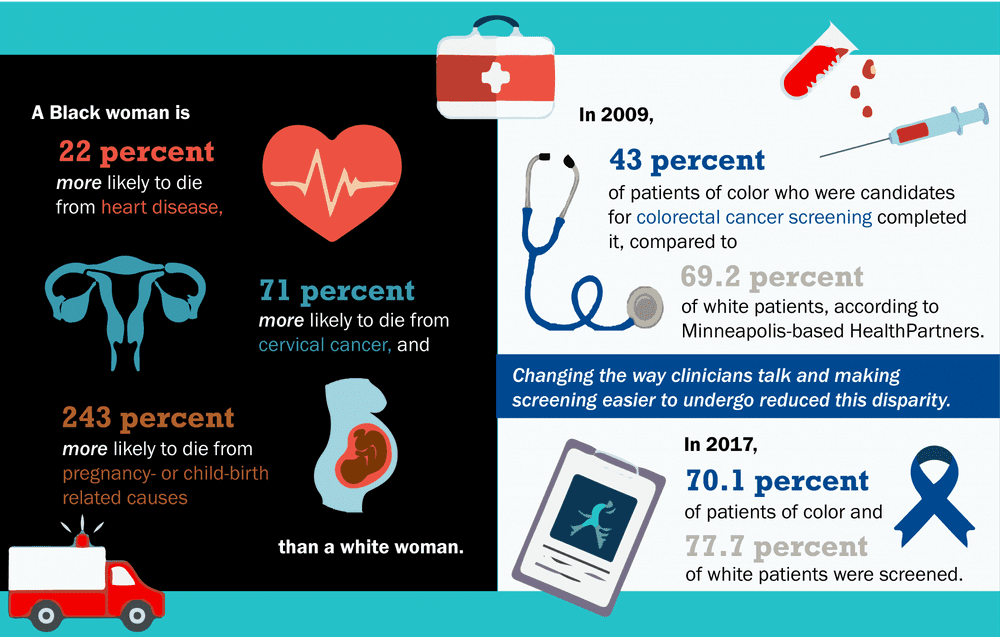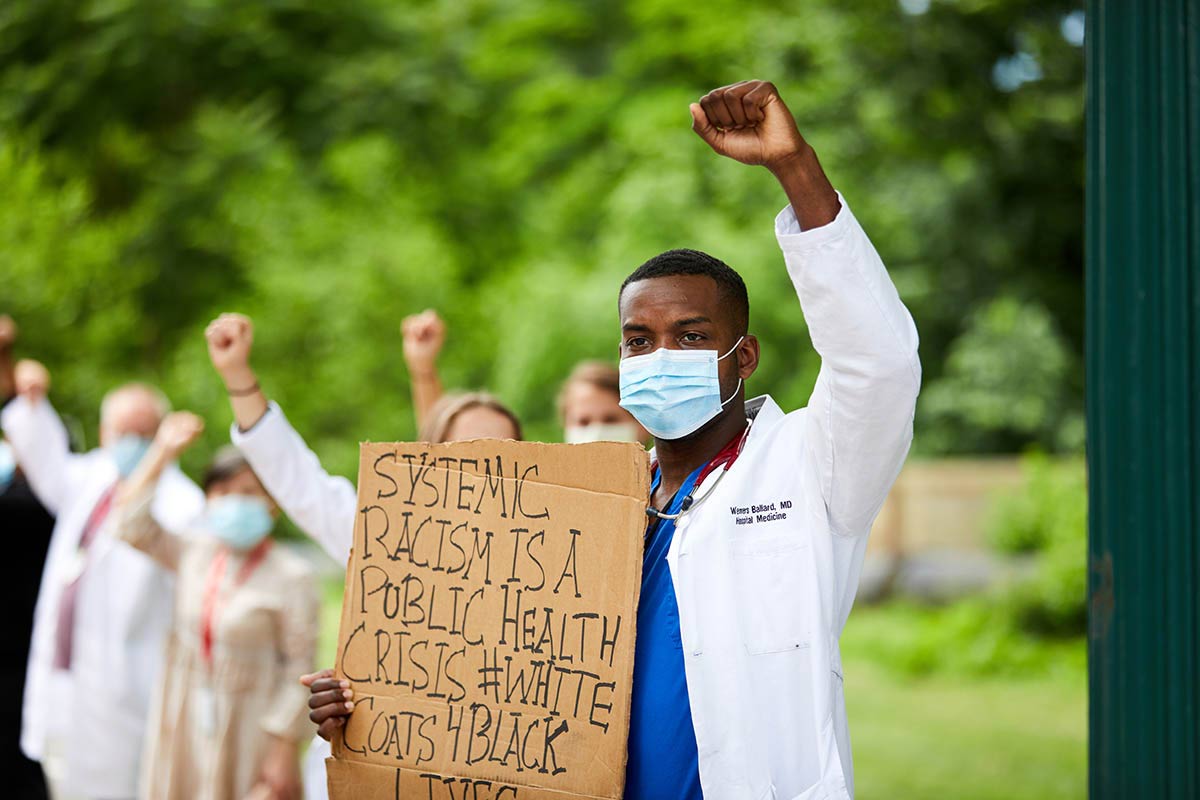But wait! First things first!! Before racism in healthcare or racism in any other realm can be intelligently discussed we need to ask ourselves what racism is, and does it really exist. For that we need to take off the blinders, remove our rose-colored glasses and look at life as it really is, the good and the bad.
Merriam-Webster defines racism as ‘a belief that race is a fundamental determination of human traits and capacities and that racial differences produce an inherent superiority of a particular race.’ There is a segment of the population that believes racism does not exist and another segment believes that racism is everywhere. The fact is that somewhere in the middle of the spectrum lies the truth about racism.
An analogy that reflects the existence of racism is quite simple, if the weatherman said that there is a ten percent chance of rain, the chances of you getting wet are small, that is unless you happen to be under ten percent. For you, it is raining 100%. So, if you experienced racism, racism is real.
‘Structural racism is the normalization and legitimization of an array of dynamics such as the historical, cultural, institutional and interpersonal that routinely advantage whites while producing cumulative and chronic adverse outcomes for people of color.’
Structural racism is woven into the fabric that is our lives, so naturally, healthcare is no exception. Through the years I had the opportunity to visit several hospitals and have found many differences. The newer, bigger hospitals have the newest equipment whereas; the older smaller hospitals have equipment that looks like it has seen better days.

The latter seem to be in areas that are less affluent or at the least the people that are served are on the lower rungs of the economic ladder. The new lends itself to a higher quality of care whereas the older ones do not. This may not be a fact; it is simply this writer’s observation.
Access to healthcare, negative racial stereotypes, poorer wellbeing of minorities and plain prejudice between doctor and patient, all can affect healthcare in an adverse way. Healthcare begins before the child is born and continues throughout one’s life. Educating the patient can go a long way toward combating racism within the healthcare system.
This may be news for some people but all of us are going to die, sooner or later. Most want it to be later (rather than sooner) and most want to maintain a quality of life. The underlying factor in maintaining a quality of life is quality healthcare or as mentioned, access to healthcare.
Racism can be linked to the disproportionately adverse effects such as infant mortality rates and mothers dying during childbirth. Black, American Indian, and Alaska Native women are two to three times more likely to die from pregnancy-related causes than white women. Improvements in healthcare, nutrition, and hygiene mean deaths are rarer today. But women as well as infants are still dying from pregnancy-related causes that are preventable.
Centers for Disease Control and Prevention (CDC) report today in the Morbidity and Mortality Weekly Report (MMWR).
www.intergroupresources.com/rc/Definitions%20of%20Racism.pdf
How many women die in childbirth?
by Hannah Ritchie
Two approaches that can address the concerns of disparity are one, by standardizing higher procedures in quality improvement programs and the other is identifying and looking at the underlying bias that exists. We have come a long way from learning that washing hands saves lives during childbirth. This realization came about as recently as 1850 when a Hungarian obstetrician Ignag Semmelweis announced that washing hands killed the bacteria transmitted between instruments, mother, and child.
This simple procedure has saved many lives through the years and yet there are many other factors that affect the health of patients to this day, most have to do with the attitudes of people rather than procedures. It is tragic that we cannot see what is in a person’s being to determine whether he or she has biases that may hinder the quality of healthcare given.
We are seeing the light at the end of the tunnel of a pandemic that had its origin in China. Covid – 19 has been politicized and scrutinized from its onset. Only history will determine the true peripherals of this disease.
 Covid is a contagious disease caused by a severe acute condition affecting the respiratory system. Coronavirus, as it is also known, has killed over three million people worldwide. Here in the United States, the number exceeds 500,000 people. This disease has been the deadliest since the Spanish Flu of 1918. These facts about covid have brought to light opportunistic people that have their own agendas and narratives, some are not sympathetic to those that are affected directly or indirectly by the disease.
Covid is a contagious disease caused by a severe acute condition affecting the respiratory system. Coronavirus, as it is also known, has killed over three million people worldwide. Here in the United States, the number exceeds 500,000 people. This disease has been the deadliest since the Spanish Flu of 1918. These facts about covid have brought to light opportunistic people that have their own agendas and narratives, some are not sympathetic to those that are affected directly or indirectly by the disease.
Racism in healthcare as it relates to Covid is twofold, first being that the disease originated in Wuhan, China, prejudice against Asians by people looking for ‘someone to blame’ is real and dangerous. The second is the inherent racism found within the healthcare system.
Through this past year, we have learned how to combat the disease. One method is by the ‘discovery’ that Dr. Semmelweis made, the simple task of washing hands will go a long way in preventing the spread of the disease. Of course, there are several other methods, many are up for discussion and debate. The difficult battles are the prejudgments that exist. Throughout history, infectious diseases have been associated with others.
People left out are in effect, finding someone to blame. One way to fight this trait is to put aside the emotion and work with logic. Are certain people, in this case Asian people, to blame for the virus? There are those on the fringe that act on emotion alone and blame ‘those people.’
The individuals that support this thinking either directly or indirectly are just as dangerous. It can be said that these people are more dangerous because they have little to lose, they just guide those that act and keep the narrative moving in a destructive direction.
Racism is a fact, racism in healthcare is real. In law, a term that is often used in litigation is, ‘a reasonable man.’ A reasonable man identifies a person that is not on the fringes and looks at an issue without prejudging.
Looking at racism in healthcare through the eyes of a reasonable man, we will see that there are many concerns that need looking into. Many of which are being addressed and positive strides are being made. As a people we need to see what we cannot see; what is in a person’s heart.
Only then we can confront racism and seriously move in a forward direction. That being nearly impossible, we must do what needs to be done, that is to educate ourselves and those that are in our circle of influence.

Nelson Mandela once said that “Education is the most powerful weapon which you can use to change the world.” As I read those words. I realized that only through education; prenatal care, mortality rates, preventive healthcare and even racism can be seriously discussed. The pieces are there, the tools, medication, and skilled medical professionals. The missing piece of the equation is educating the patient. An educated patient will ask for and when needed, demand, quality healthcare.
At Specialty Care Clinics, we believe that racism is a rot. It can rot your relationship with your patients. That’s why we are proactive in checking and weeding out any racist tendencies in our staff.
We value our patients and we’re proud to boast of a racially diverse staff and equal treatment of all patients who walk through our doors. We’re lucky enough to live in a modern, anti-racist world and we are trying our hardest to keep it that way.
Call us on 469-545-9983 to book an appointment today for your illness.
